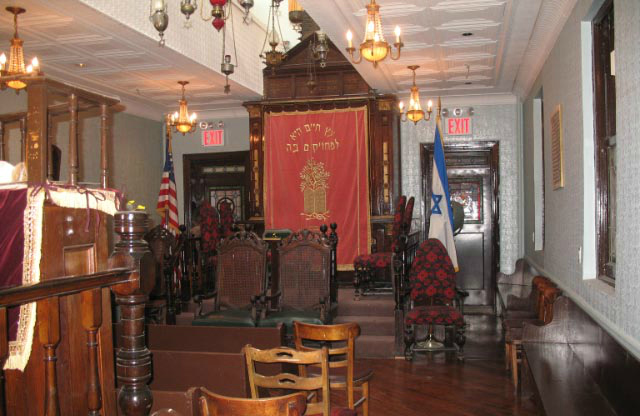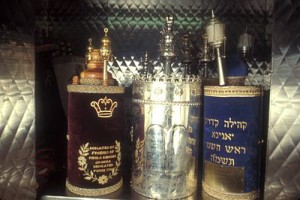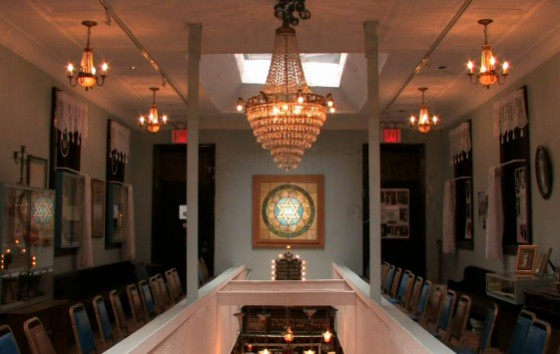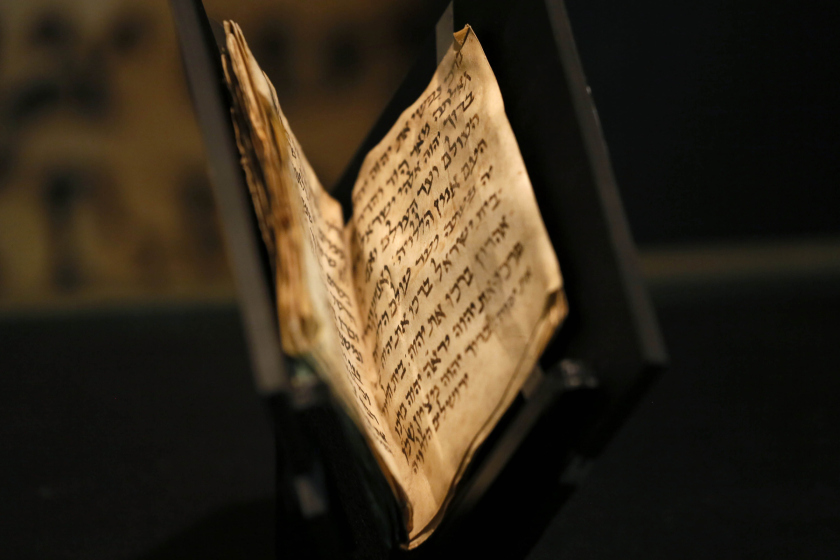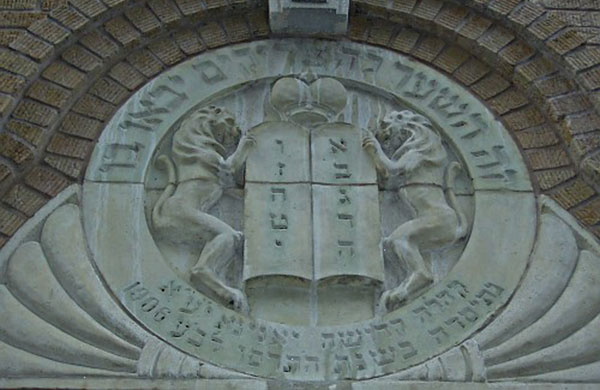
A festive trip to Congregation Kehila Kedosha Janina, the only Romaniote synagogue in the Western Hemisphere
This past Sunday, strings of Greek, Israeli and American flags danced in the breeze over a Lower East Side block. The air smelled of honey. Long lines of people waited to nosh on baklava and biscochos, a traditional Sephardic cookie. Under a big banner reading YASOU! a diverse crowd of Jews, Latinos, Chinese-Americans—along with the typical mix of white-sneaker-wearing fanny-pack-sporting tourists and local hipsters with expensive haircuts—listened to live bands rocking out with ouds and daoulis. (I especially enjoyed the awesomely-named Pontic Firebird, which plays dance music from the western Pontic zone of the Black Sea.)
The Greek Jewish festival was sponsored by Kehila Kedosha Janina, a tiny synagogue on Broome Street between Eldridge and Allen Streets. I’d passed it many times—it’s only a few blocks from my apartment—assuming that it was one of the many small shuls in the neighborhood that had become fancy condos. But no: Kehila Kedosha Janina is the only Romaniote synagogue in the Western Hemisphere.
The Romaniotes are a people who view themselves as neither Ashkenazi nor Sephardi. According to their oral tradition, they’re descended from Jews who were put on a slave ship to Rome after the destruction of the Second Temple in Jerusalem in 70 CE; a storm grounded the ship in Greece, and there they stayed for 2000 years. Their unique culture flowered. They didn’t speak Ladino, the Spanish-Hebrew hybrid language of Sephardic Jewry; they spoke their own Judeo-Greek language, sometimes called Yevanic—a mix of Greek, Hebrew and Turkish with a few Spanish words thrown in.
The Romaniotes were acculturated people, living peacefully among their non-Jewish neighbors while retaining their own traditions. Then, during the Middle Ages, Jews fleeing persecution in Italy, France and Germany made their way to Greece as well, and after 1492, they were joined by Sephardic Jews who’d been expelled from Spain. Many Romaniote communities were absorbed into the broader, wealthier Sephardic culture. But Jews in the isolated town of Janina (or Ionnina), near Greece’s Albanian border, kept their Romaniote heritage alive.
These Jews wound up founding Kehila Kedosha Janina. They began arriving in New York shortly before the turn of the 20th century, during that period of American history when so many Jewish immigrants converged on the Lower East Side. They founded their congregation in 1906 and built the shul in 1927. They wanted a place of worship of their own—most of the other Jews on the Lower East Side were suspicious of them, doubting their Jewishness because they looked different and spoke no Yiddish.
Today, the building is a New York City historic landmark. Like most Sephardic shuls, it has a central pulpit with benches surrounding it. It has lovely stained glass windows and several vintage Greek Torahs, including one of only three extant Torahs written in Romaniote script. All over the walls and in cases around the women’s section in the balcony are artifacts from the old world: faded photos of Janina’s former residents, lavish robes, silver-encased megillah scrolls, a pair of beautifully carved and inlaid wooden platform sandals that women wore to the mikvah.
There’s also a collection of intricately calligraphed Alefs, hand-painted Romaniote amulets given to baby boys at their brit milah. Covered in the names of the forefathers, as well as the child’s father and grandfather, Alefs, adorned with illustrations and mystical writing, served as both a historical document and a symbol of protection from the evil eye. “The Alef hangs over the baby’s cradle for 40 days to protect him,” Marcia Haddad Ikonomopoulos, the director of the shul’s museum (as well as the President of The Association of Friends of Greek Jewry), told me in an interview. “It’s a Kabbalistic thing. The only other communities who had the Alef were close to Janina.”
Many families in Janina were poor, and women’s names in the town sometimes reflected parents’ desire for a boy. Boys, obviously, didn’t require dowries. In a fascinating piece for the synagogue’s newsletter, Ikonomopoulos lists some of the women’s names: “Perna” (from the Greek “pernas”—to pass) was a name for a girl with older sisters; her parents were literally praying for the curse of daughters to pass. “Stemma” (from the Greek “stamata”—to stop) was a prayer for the plague of daughters to stop. Ikonomopolus noted, “One of the members of our congregation with the name of Stemma [survived] because, as the last of many daughters in a poor home, her family sent her to the United States in the 1930s with a cousin, hoping that here where a dowry was not a requirement, they would be able to marry her off. The rest of her family, including all her older sisters with their husbands and children, would perish in the Holocaust.”
Looking at the embroidery patterns and fezzes throughout the building, you can see the Turkish influence on Janina’s artifacts. Janina was conquered by Ottoman Turks in 1430 and remained under Turkish rule for nearly 500 years. This meant that Turkish foods, design, and words were joined with Jewish and Greek elements in the vernacular. Ikonomopoulos described some of the new surnames that cropped up during this period: “Hadjis” (from Turkish “hadj,” someone who had made a pilgrimage—in this case, for Jews—to Jerusalem), and “Hadjopoulos,” with the Greek ending “poulos,” meaning “son of,” or the son of someone who made a hadj. These names reflect Greekness, Turkishness and Jewishness all at once.
Unfortunately, acculturation ultimately didn’t protect the Jews of Janina. Nearly 90% of Greek Jews died in the Holocaust, the largest percentage of any European country in WWII. Today, Greece suffers from growing anti-Semitism that plagues much of Europe.
But the members of Kehila Kedosha Janina still feel a connection to their homeland. As Ikonomopoulos told me, “I never have met any Ashkenazim who described themselves Polish or Russian. But we’re proud to be Jewish, American and Greek. We have no trouble wearing all three hats. Our congregation goes on tours of Janina, and the ages of people on the tours range from 19 to 83. It’s so different from the Ashkenazi world. How many of you guys go home? And if you do, you say, ‘Thank God we got out!’ But we go back to visit, to celebrate Bar Mitzvahs. When we arrive, our eyes well up with tears. It’s a multi-tissue event.”
She concluded, “I’d like the world to know how very special this community is. It’s absorbed the true essence of Judaism—knowing who we are and passing it on to our children and grandchildren. We’ve preserved this older world and still take advantage of the wider world.”

